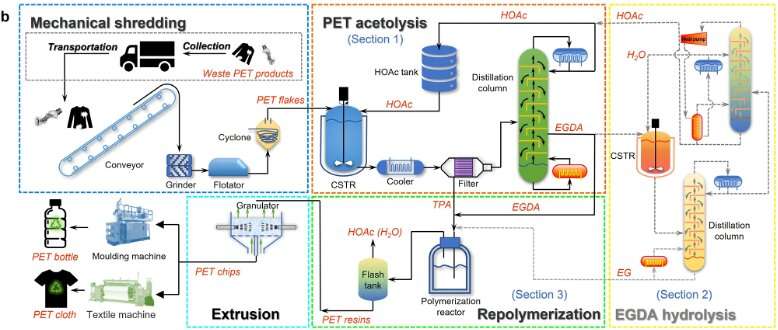This article has been reviewed according to Science X's editorial process and policies. Editors have highlighted the following attributes while ensuring the content's credibility:
fact-checked
peer-reviewed publication
proofread
New strategy for polyethylene terephthalate upcycling

Polyethylene terephthalate (PET), one of the most consumed synthetic polyesters, has a challenging recycling process. Current PET recycling methods have achieved downcycling, which produces low-value products like PET textiles. Due to the limitations of existing techniques and production costs, it is difficult to realize upcycling industrially.
In view of this, a team led by Prof. Fu Yao and Prof. Deng Jin from the University of Science and Technology of China (USTC), collaborating with Prof. Li Shen from Utrecht University, proposed a new scheme for upcycling waste PET via chemical depolymerization of acetic acid. Their work was published in Nature Communications on June 5.
The researchers used acetic acid to depolymerize waste PET and achieved efficient recycling of PET into high purity terephthalic acid. Another high-value product in the acetolysis of PET is ethylene glycol diacetate, which can be hydrolyzed to ethylene glycol or polymerized with terephthalic acid to form polyethylene terephthalate. On the basis of this, the researchers further proposed a closed-loop PET upcycling strategy and assessed its life cycle.
The results show that compared with existing commercialized chemical recycling methods, namely synthesizing PET polyester from fossil resources, the nonrenewable energy use and global warming potential of their new process can be reduced by more than 70% and 40%, respectively. This new strategy has the lowest impact on the environment among all the PET recycling methods proposed thus far.
This research provides an environmentally friendly and low-carbon pathway to realize the upcycling of waste PET with lower industrial costs. Furthermore, the team's new upcycling strategy utilizes acetic acid, which is widely used in the industrial production of terephthalic acid. Therefore, this strategy can be easily adapted to current industrial equipment and widely promoted.
More information: Yuantao Peng et al, Acetolysis of waste polyethylene terephthalate for upcycling and life-cycle assessment study, Nature Communications (2023). DOI: 10.1038/s41467-023-38998-1
Journal information: Nature Communications
Provided by University of Science and Technology of China





















